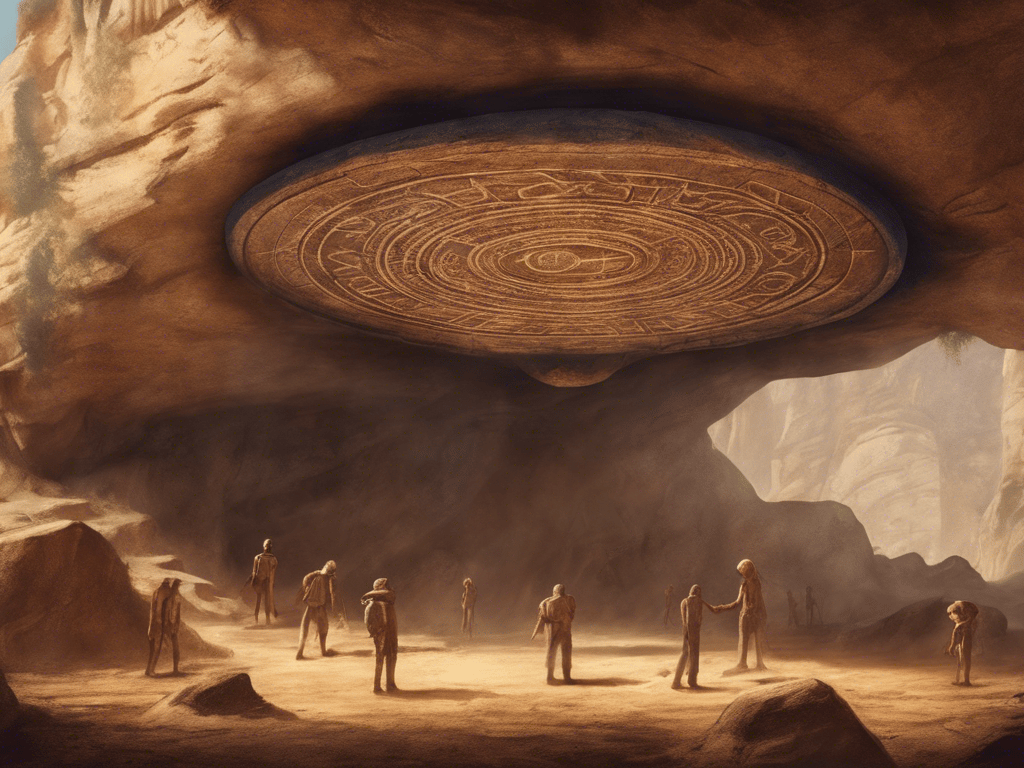Exploring Extraterrestrial Contact in April 2024.
In recent times, the subject of extraterrestrial contact has seized the collective imagination in an unprecedented manner.
UAP/UFO/USOHUMAN ORIGINS?
4/9/20245 min read


Introduction: With disclosures emanating from governmental sources and a surge in public dialogue, there arises a burgeoning interest in grasping the ramifications of such encounters. Follow me as I plunge into the historical backdrop, contemporary advancements, and prospective future scenarios pertaining to extraterrestrial interactions.
Historical Perspectives: A retrospective exploration of extraterrestrial encounters unveils a tapestry rich in narratives, symbols, and rituals interwoven into the fabric of human civilization over millennia. Ancient civilizations, spanning from the Sumerians to the Egyptians, have left behind enigmatic artifacts and texts hinting at their rendezvous with celestial entities. Cave paintings depicting radiant beings descending from the heavens and intricate stone carvings portraying visitors from other realms offer tantalizing glimpses into humanity's early endeavours to fathom the cosmos.
Moreover, religious scriptures and mythologies from across the globe teem with tales of divine visitations, celestial chariots, and heavenly emissaries. From the grand sagas of the Mahabharata in Hinduism to the Book of Ezekiel in Judaism and Christianity, these age-old texts abound with vivid depictions of encounters with beings from realms beyond. Through a comparative analysis of these narratives, scholars can discern recurring motifs, archetypal symbols, and cultural interpretations of extraterrestrial contact across diverse civilizations.
Additionally, the ancient astronaut theory posits that many of these mythic accounts may have stemmed from actual encounters with technologically advanced beings from distant planets. Advocates of this theory cite the striking parallels between ancient depictions of deities and modern descriptions of extraterrestrial visitors, hinting at a continuity of experience that transcends temporal and spatial boundaries. By critically engaging with this thought-provoking hypothesis, researchers can probe alternative explanations for the genesis of human civilization and the nature of our rapport with beings from beyond Earth.
Furthermore, indigenous cosmologies offer distinctive perspectives on extraterrestrial contact, grounded in interconnectedness, reciprocity, and reverence for the natural world. Indigenous cultures worldwide, from the Aboriginal peoples of Australia to the Native American tribes of North America, have preserved oral traditions and sacred rituals venerating their forebears, star beings, and celestial custodians. By heeding the wisdom of indigenous elders and storytellers, we can glean profound insights into humanity's cosmic origins, spiritual progression, and ecological stewardship.
In essence, the exploration of extraterrestrial encounters through a historical lens beckons us to transcend cultural confines, challenge preconceived notions, and embrace the diversity of human experience. By interweaving perspectives from indigenous cosmologies, the ancient astronaut theory, and comparative mythology, we can cultivate a more nuanced comprehension of how varied cultures have construed and assimilated extraterrestrial contact into their worldviews. Through interdisciplinary discourse and cross-cultural interchange, we can honour the sagacity of our forebears, expand our cosmic consciousness, and envisage a more inclusive conception of humanity's position in the cosmos.
Contemporary Developments: In recent times, there has been a discernible surge in official disclosures from governmental bodies, notably from the Pentagon, concerning encounters with unidentified flying objects (UFOs/UAPs), and research initiatives apprently associated with extraterrestrial materials. These disclosures, coupled with testimonies from credible sources, have ignited conjecture and discourse regarding the nature of these encounters and their potential ramifications for humanity. The release of once classified information, and the acknowledgment of ongoing research endeavours have thrust extraterrestrial phenomena into the limelight, eliciting widespread public interest and scrutiny. As the discourse surrounding extraterrestrial contact continues to evolve, it is imperative to critically scrutinize these developments and their broader societal, cultural, and scientific implications.
Speculation on Future Disclosures: Looking ahead, there is widespread speculation regarding the prospect of further official disclosures in the ensuing years. With mounting pressure for transparency and accountability, it is conceivable that additional information pertaining to UFO/UAP encounters and extraterrestrial materials will be divulged. This could potentially reshape public perception and engender a deeper comprehension of the phenomenon.
Potential Implications and Responses: The implications of extraterrestrial contact transcend mere curiosity, touching upon geopolitics, economics, societal structures, and existential queries regarding humanity's position in the cosmos. As we contemplate the potential ramifications of such contact, it is imperative to approach the subject with an open mind and a willingness to engage in cogent debate. Rather than succumbing to fear or alarm, we should strive for a balanced and inclusive approach to understanding these phenomena.
Encouragement for Engagement and Hope: Despite the uncertainties surrounding extraterrestrial contact, there exists cause for optimism. By embracing curiosity, creativity, and collaboration, we can navigate the complexities of this phenomenon and chart a course towards a more enlightened future. Whether through scientific inquiry, cultural exchange, or philosophical contemplation, there abound myriad opportunities for engagement and exploration. As we embark on this odyssey, let us do so with hope, humility, and a sense of wonder.
Conclusion: The subject of extraterrestrial contact is multifaceted and intricate, touching upon facets of history, science, culture, and society. By examining historical perspectives, contemporary developments, and potential future scenarios, we can attain a deeper understanding of this phenomenon and its implications for humanity. Whether through official disclosures, cultural narratives, or scientific inquiry, there is much to be gleaned and explored. As we continue to grapple with the mysteries of the cosmos, let us do so with an open mind and a sense of curiosity, cognizant that the journey itself is as enlightening as the destination.
NB: (nota bene): On March 20, 2024 the UAP: Reporting and scientific assessment in the EU. Took place, an exchange of views in the European Parliament.
Below is a summary for you of the exchange of views covered in this meeting:
1. Political Objectives: The event aimed to initiate a debate within the European Parliament on unidentified anomalous phenomena (UAP) and decrease the stigma associated with the topic. Recent developments in the USA on the subject have also prompted attention.
2. Scientific Assessment: The discussion emphasised the need to scientifically assess UAP sightings, with specific attention to the characteristics that make them unique, such as positive lift, instantaneous acceleration, and hypersonic speeds.
3. Protocols for Reporting: There is a call for establishing clear protocols and procedures for reporting UAP sightings, including channels for pilots, military personnel, and other trained observers to report sightings. This also includes the incorporation of UAP explicitly in relevant EU legislation, such as aviation safety laws.
4. International Efforts: The exchange highlighted international efforts in studying UAP, with mentions of countries like the USA and France opening their UAP archives for study. Efforts by organisations like NASA to investigate UAP were also noted.
5. Testimonies and Witness Accounts: Testimonies from individuals like Ryan Graves, a former F-18 pilot, provided firsthand accounts of encounters with advanced UAP. Graves emphasized the frequency of UAP sightings and the need for improved reporting and data collection.
6. Challenges and Solutions: Challenges in addressing UAP were acknowledged, including the need for improved reporting, data transparency, and funding for research. Efforts to destigmatize discussions around UAP and involve civil society in the dialogue were also highlighted.
7. Policy Recommendations: Suggestions were made for policy actions, including the inclusion of UAP reporting fields in aviation safety forms and educational efforts to raise awareness among pilots. There was also a call for political leadership in the EU to address the topic seriously.
Overall, a comprehensive discussion on UAP, covering political, scientific, and policy aspects, with an emphasis on the need for increased attention, research, and collaboration at both national and international levels.
I hope you find this of interest, from one potential Kindred Voyager to Another ~ Nigel John Farmer

© 2024~2025 MeditatingAstronaut.com - All Rights Reserved Worldwide
website by Meditating Astronaut Publishing
